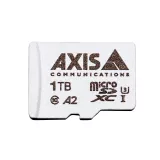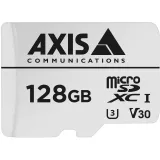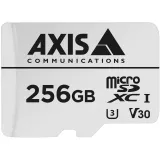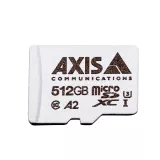Edge storage

Not all surveillance cards are created equal. Axis SD cards are optimized for surveillance and offer greater functionality and endurance compared to traditional SD cards. They can be used as primary or redundant storage and are ideal in low-bandwidth environments.
Beyond backups
Edge storage, typically implemented using SD cards, allows you to store data locally—directly on your device. And it’s not just a backup option. Using Axis surveillance cards, you can record high-resolution video both as primary and redundant storage. When used as primary storage on your device, SD cards can reduce the need for additional servers and recorders and lower the total cost of ownership. Edge storage can also complement your primary storage, so you can continuously store video on the edge in parallel with your Video Management Software (VMS). This means that even when your VMS is unavailable, SD cards can help to minimize the loss of video recordings.

Increased endurance
These specialized AXIS Surveillance Cards are designed to endure continuous use and are available with 128 GB, 256 GB, 512 GB, and 1 TB. They offer longer lifespans compared to standard SD cards, often stretching beyond ten years. Plus, a 5-year Axis warranty delivers years of trouble-free ownership. So, you’ll benefit from reduced maintenance costs and greater cost-efficiency. Axis SD cards also offer effective retention times, even at high frame rates and resolutions. Additionally, with built-in health monitoring features, you can keep track of how worn out the card is and be notified when a replacement is needed.

Secure, uninterrupted service
Axis surveillance cards are ideal for remote locations, onboard installations such as trains and buses, and other areas where network availability is limited. They offer encryption features to protect the stored data from unauthorized access in case of theft or compromise. And, if needed, recordings can be quickly and securely transferred to a central system such as a VMS. Furthermore, these industrial-grade cards can withstand temperatures from -25°C (-13°F) to 85°C (185°F), ensuring reliability in extreme conditions.

Great benefits for analytics
Running analytics on the edge offers great benefits and can enhance the overall performance of the analytics applications. That’s because data is processed locally in real-time—no need to send the data to a server for analysis. When the analytics detect an event, such as motion detection, it’s possible to trigger automated actions directly from the camera. This allows for timely decision-making so you can respond faster—vital in emergency situations. By processing and storing data locally, you can reduce bandwidth and storage costs. Furthermore, thanks to media-to-cloud storage, you can easily select what data to transfer to the server, making it easier to comply with privacy regulations.

Seamless integration
Supported by AXIS Camera Station and leading partner VMSs, Axis SD cards help enhance your surveillance system and ensure greater robustness and flexibility. Plus, they reduce server-related and other costs, improve overall systems performance, and increase efficiencies all while ensuring the secure transfer of data. What’s more, by offloading heavy processing tasks to edge devices you can reduce the processing burden on other components of the system, enhancing scalability, savings costs, and simplifying server maintenance.
How to choose the right Axis surveillance card
It can be challenging to know what capacity SD card is needed for your specific use case. To guide you in this choice, tables have been created to make this clearer. In the tables below, some of the most common scenarios are represented. These are based on the main video compression standards H.264 and H.265 and the parameters: framerate, bitrate, use of Zipstream, and, of course, the required retention time that is needed.
Retention time = The amount of data/recording stored on the SD card in days, before it gets rewritten.
Important to note: the main driving parameter in choosing the right capacity SD card is the bitrate. The suggested camera resolution is only to give an idea of the type of product it correlates to. If you know your bitrate and retention time, then the choice should be clear. As an additional help, you can also find a table based on the default recording settings within ACS Edge.
| SD card selector: H.264 | ||||||||
| 24-30 fps Video* | 12-15 fps Video* | |||||||
| Bitrate | 0.40 Mb/s 4.32 GB/d | 0,89 Mb/s 9.61 GB/d | 2.11 Mb/s 22.79 GB/d | 3.56 Mb/s 38,45 GB/d | 0.29 Mb/s 3.13 GB/d | 0.64 Mb/s 6.91 GB/d | 1,52 Mb/s 16.42 GB/d | 2.57 Mb/s 27,76 GB/d |
| Typical camera resolution** | 1 MP (720P) | 2 MP (1080P) | 5 MP | 8 MP (4K) | 1 MP (720P) | 2 MP (1080P) | 5 MP | 8 MP (4K) |
| 15 days retention | 128 GB | 256 GB | 512 GB | 1 TB | 128 GB | 128 GB | 256 GB | 512 GB |
| 30 days retention | 128 GB | 512 GB | 1 TB | - | 128 GB | 256 GB | 512 GB | 1 TB |
| 60 days retention | 256 GB | 1 TB | - | - | 256 GB | 512 GB | 1 TB | - |
| 90 days retention | 512 GB | 1 TB | - | - | 512 GB | 1 TB | - | - |
| 120 days retention | 512 GB | - | - | - | 512 GB | 1 TB | - | - |
| 240 days retention | 1 TB | - | - | - | 1 TB | - | - | - |
*Use case: One highest resolution H.264 stream continuous recording, Zipstream with 30% compression
** Typical camera resolution: Bitrate is the correct driving factor, which can vary significantly within the same camera resolution
| SD card selector: H.265 | ||||||||
| 24-30 fps Video* | 12-15 fps Video* | |||||||
| Bitrate | 0.28 Mb/s 3.02 GB/d | 0.64 Mb/s 6.91 GB/d | 1.50 Mb/s 16.20 GB/d | 2.53 Mb/s 27.32 GB/d | 0.14 Mb/s 1.51 GB/d | 0.32 Mb/s 3.46 GB/d | 0.75 Mb/s 8.10 GB/d | 1.26 Mb/s 13.61 GB/d |
| Typical camera resolution** | 1 MP (720P) | 2 MP (1080P) | 5 MP | 8 MP (4K) | 1 MP (720P) | 2 MP (1080P) | 5 MP | 8 MP (4K) |
| 15 days retention | 128 GB | 128 GB | 512 GB | 1 TB | 128 GB | 128 GB | 256 GB | 256 GB |
| 30 days retention | 128 GB | 256 GB | 1 TB | 1 TB | 128 GB | 128 GB | 512 GB | 512 GB |
| 60 days retention | 256 GB | 512 GB | - | - | 128 GB | 256 GB | 1 TB | 1 TB |
| 90 days retention | 512 GB | 1 TB | - | - | 256 GB | 512 GB | 1 TB | - |
| 120 days retention | 512 GB | 1 TB | - | - | 256 GB | 512 GB | - | - |
| 240 days retention | 1 TB | - | - | - | 512 GB | 1 TB | - | - |
*Use case: One highest resolution H.264 stream continuous recording, Zipstream with 30% compression
** Typical camera resolution: Bitrate is the correct driving factor, which can vary significantly within the same camera resolution
SD card selector: Default recording settings in ACS Edge
| ||||
| Bitrate | 0.18 Mb/s 1.94 GB/d | 0.39 Mb/s 4.21 GB/d | 0.91 Mb/s 9.83 GB/d | 1.43 Mb/s 15.44 GB/d |
| Typical camera resolution** | 1 MP (720P) | 2 MP (1080P) | 5 MP | 8 MP (4K) |
| 15 days retention | 128 GB | 128 GB | 256 GB | 256 GB |
| 30 days retention | 128 GB | 256 GB | 512 GB | 512 GB |
| 60 days retention | 128 GB | 512 GB | 1 TB | 1 TB |
| 90 days retention | 256 GB | 512 GB | 1 TB | - |
| 120 days retention | 256 GB | 1 TB | - | - |
| 240 days retention | 512 GB | - | - | - |
** Typical camera resolution: Bitrate is the correct driving factor, which can vary significantly within the same camera resolution

Find a compatible accessory
Find a compatible accessory



